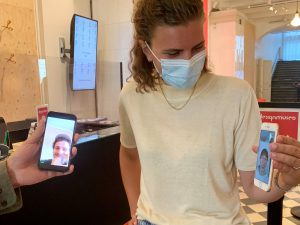Helsinki design Residency 2020 seminar will be organized on Sep 10th 9.00 – 12.00. (The presentations will start at 9.30)
In this online/on-site seminar you get to meet the participants of this years residence, the event will be hosted by the producer of Helsinki Design Residency Martin Born.
Join the event either on-site at Design Museum’s auditorium or online. Please book your seat in advance: info@designmuseum.fi When booking your seat, please tell us your name and specify will you be attending the online or on-site event. We will send a link to the online event to all participants day before the event.
The Design Museum met Mikaela Steby Stenfalk, Maxim Spivakov and Mayumi Niiranen-Hisatomi, participants of this year’s Helsinki Design Residency, to discuss their practices and their experience of a residency that under the impression of the COVID-19 pandemic has been conducted partly en remote this year. Following a tour of the museum’s current exhibition, Travel as a Tool, that spotlights different ways in which travel has influenced Nordic designers since the 1940s, we sat down with the three and Martin Born, the residency program’s curator. Spivakov and Niiranen-Hisatomi joined the tour and the discussion digitally.
The personal and work biographies of the practitioners have evolved as particles of cultures in which traveling has made for a crucial portion of their working methods, idea exchanges and sources of inspiration, of which staying in a foreign country for a residency program is but one exemplary expression. It thus felt acute to discuss how they experience a world that suddenly has become so much more isolated.
In recent months, Mikaela Steby Stenfalk has discovered that before COVID-19 she explored public space through social media, but even though the images of public space increased in value when the actual space became inaccessible, images are not enough to replace it.
– A collection of images of public space can never replace the original, because public space is much more than what meets the eye, especially in terms of democracy – as has also has become clear through other large events taking place this spring.
But pointing that out, she also underlines that at the same time social media was as an important window to the outside world.
In her work through sculptural pieces, architectural spaces, exhibitions, texts and films, she reflects reproduction and archival processes in the age of the internet, as well as our growing relationship to digital landscapes and the ties to public life. In the spring, this relationship has been tested very intensely.
Maxim Spivakov is a visual artist, designer, and researcher based in Moscow. He wonders that the current restrictions on mobility present an opportunity for revisiting a deeper point in the cultural conception of travelling.
– Maybe what we see at this moment is that we have been travelling too much, but not in a nomadic way. Wherever we went, we felt ourselves at home all the time. Perhaps this circumstance allows us to find ways to a radical form of nomadism in which the task is to stay in one place but feel ourselves in the flux – in the wholesome flow of difference, and of the different forces that there are.
Spivakov’s practice spans from painting and installation to design and research. In the past years, his work was mainly focused on the vicissitudes of the image, modes of visibility, and the political imagination. His current research concerns the problem of techno-aesthetics as reciprocal implications of technicity, sensations and desire.
Mayumi Niiranen-Hisatomi is a Finland-based Japanese artist who produces works in a wide range of mediums, including painting, textile, installation and text.
– In the past months, home has been kind of a safe place, which felt great compared to the earthquake I experienced in Japan when I was a child. This COVID-19 has felt so much easier than what I experienced then, underlines Niiranen-Hisatomi from Kajaani.
Home has now got a new meaning as a safe zone. But she has missed the opportunities to work outside with museums and galleries. In her view institutions have not rapidly enough encountered the new situation. So instead, she has taken to creating rock paintings in a forest, for example.
Niiranen-Hisatomi makes her works with persistence, with many of her pieces taking years to complete. In 2017 she started to use Urushi in her work, a traditional Japanese lacquering technique that is applied in many layers.
Text: Päivi Balomenos

